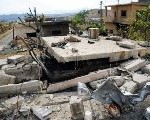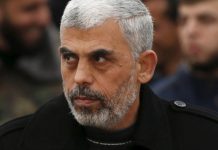 Israel did not seek permission from the United States before launching two missile strikes this weekend hitting targets inside Syria-but the strikes were part of a policy that Washington had already signaled its acquiescence to, according to U.S. and Israeli officials.
Israel did not seek permission from the United States before launching two missile strikes this weekend hitting targets inside Syria-but the strikes were part of a policy that Washington had already signaled its acquiescence to, according to U.S. and Israeli officials.
In a series of high-level meetings between U.S. and Israeli officials over the last year, the Israelis explained in detail the conditions that would lead them to attack targets inside Syria. Israel’s “red lines,” articulated in private and public, include the shipment from Iran of advanced anti-aircraft weapons, advanced missiles, and chemical or unconventional weapons to the Lebanese militia and political party Hezbollah, according to public reports and U.S. officials.
While Iran has sent conventional arms through Syria to Hezbollah for years, Israel is concerned that the Islamic Republic may now be sending the Lebanese militia advanced weapons designed for national armed forces, including rockets with the range to put most of Israel’s population at risk of attack, shore-to-ship missiles of the sort Hezbollah successfully used in its 2006 war with Israel, and advanced anti-aircraft weaponry. Another red line for Israel would be if sarin gas or other chemical weapons possessed by the Syrian government found their way to Hezbollah in the midst of Syria’s bloody and chaotic civil war.
“In general they told us in every possible way that this kind of strike would be coming,” said a U.S. intelligence official. Another U.S. official said, “Israel shares its intelligence on Syria with us almost in real time. These latest strikes were an example of Israel enforcing its own red lines.”
This two strikes this week were the first since one in January, also apparently aimed at Hezbollah-bound weaponry. The New York Times reported Sunday that the targets this weekend included a warehouse at Damascus International Airport, with stocks of the Fateh-110 missile-a solid-fuel missile that would give Hezbollah the capacity to strike Tel Aviv. That was followed by a second strike that hit the Center for Scientific Research in Jamraya, a military facility in a suburb of Damascus. The Wall Street Journal reported that both attacks were launched from Lebanese airspace.
President Obama signaled Sunday that the U.S. had no objections to the strikes. “What I have said in the past and I continue to believe is that the Israelis justifiably have to guard against the transfer of advanced weaponry to terrorist organizations like Hezbollah,” the president told Telemundo. “We coordinate closely with the Israelis, recognizing they are very close to Syria, they are very close to Lebanon.”
That approach contrasts with Obama’s sometimes open spats with Israeli Prime Minister Benjamin Netanyahu over the prudence of attacking Iran. While the two leaders have recently said they share the same view of intelligence on Iran’s progress toward achieving a nuclear weapon, they’ve drawn very different red lines for when a military response would be warranted. While the U.S. has vowed to top Iran from attaining a nuclear weapon, Israel has vowed to stop the Islamic Republic from acquiring the capability to make one, a significantly lower threshold.
Dore Gold, a former Israeli ambassador to the United Nations who is the president of the Jerusalem Center for Public Affairs, said, “Iran shows no reluctance to share its most advanced conventional weapons with Hezbollah. This raises the question of whether Iran is preparing to transfer unconventional weapons capability.”
Those concerns come as U.S. military commanders publicly have acknowledged that the United States no longer knows where many of the Syrian government’s chemical weapons stocks are now located.
The precedent of the U.S. making allowances for Israel military actions inside Syria in some ways dates back to the Bush administration. Condoleezza Rice, the secretary of state and national-security adviser under George W. Bush, wrote in her memoir, for example, that both she and then-Defense secretary Robert Gates were skeptical of Israeli claims in 2007 that Syria was developing a nuclear-weapons program at the al-Kibar nuclear facility in Syria in 2007-and encouraged President Bush to decline Israeli Prime Minister Ehud Olmert’s request that the U.S. take out the facility. After CIA director Mike Hayden said he had only low confidence that the reactor there was in fact part of a weapons program, Bush rejected the request, and Israel destroyed the facility itself, without American permission. Neither side publicly confirmed the strike. In 2008, several months after the Israeli strike, the Bush administration made public intelligence that it said confirmed the Syrian site had indeed housed a nuclear reactor. The White House also shared with Congress video of North Korean nuclear scientists at the facility.
Much has changed for Israel since 2007. In recent years, the Israel Defense Forces have quietly adopted a new doctrine to target Iran’s weapons network throughout the Middle East, including through targeted killings, drone attacks, and military actions in other countries. Those actions have included the 2010 assassination of Mahmoud al-Mabhouh, a Hamas military commander, in his hotel room at Dubai, United Arab Emirates, in a somewhat botched operation in which the killers were captured on camera. That same year, Israeli drones fired on al-Mabhouh’s successor, Abdel Latif al-Ashqar, in Sudan. In 2011 Israeli Mossad commandos kidnapped in Ukraine an alleged Hamas operative named Dirar Abu Sisi, who had emigrated there that year to seek citizenship.
At the end of 2011, the Israel Defense Forces created a new strategic command that placed elite military units that worked in foreign countries, often in secret, under a single command structure similar to U.S. Joint Special Operations Command, the operational command for Navy SEALs and the U.S. Army’s Delta Force. “The depth command is a clear signal to Iran,” an Israeli defense official told The Daily Beast in March. “We are willing to go wherever we need to go to stop you.”
Lt. Gen. Benny Gantz hinted at this approach in March when he addressed the annual strategic conference at Herzliya, signaling Israel’s willingness to use military force to stop weaponry originating in other countries from reaching Israel’s enemies in Lebanon and Gaza.
“If we have to go into a village and under the ground, that is something we will make sure we are flexible enough to do, that we are able to adapt ourselves to the new situation. We will have to do other things as well. From dozens of places in the world we are being attacked, they are looking at us, and they are watching us,” Gantz said
Source: THE DAILY BEAST
{Matzav.com Newscenter}













